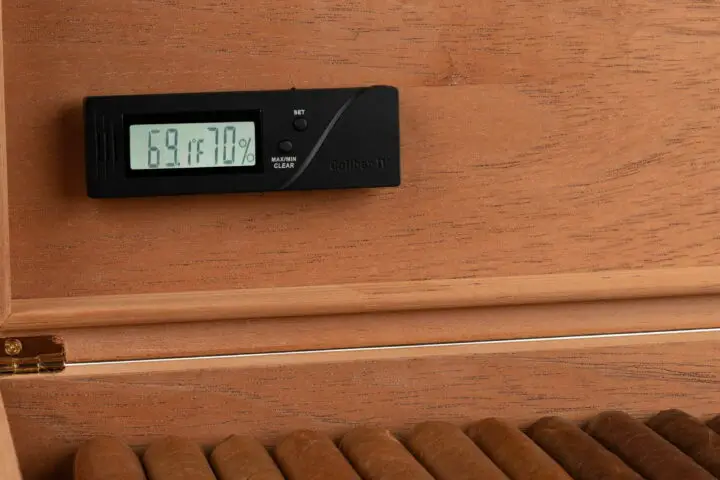When understanding our environment, temperature is just half the story. Humidity, or the amount of moisture in the air, plays a significant role in how comfortable we feel and the health of our surroundings. Maintaining the proper humidity level is key to keeping cigars fresh in a humidor and preventing mold in our homes.
That’s where hygrometers come in. These handy tools measure the humidity in the air, helping us make informed decisions about our environment. This guide has rounded up the top five hygrometers available on Amazon. Many also measure temperature, giving you a complete picture of your surroundings. Let’s take a closer look at the best options out there.
Understanding Hygrometers
At its core, a hygrometer is a device designed to measure the amount of water vapor (humidity) in the air. This data is used to determine the relative humidity, or the percentage indicating how much water vapor is in the air compared to the maximum amount the air can hold. You often see this percentage in weather reports.
The significance of humidity extends beyond weather forecasts. Indoors, it influences our comfort levels and promotes or inhibits mold growth. Proper moisture ensures the longevity of food and other perishables. Extreme humidity levels, both high and low, can affect our well-being. High humidity can feel oppressive and worsen health issues, while low humidity can lead to problems like static electricity. Owning a dependable hygrometer can make a real difference in understanding and managing our environment.
Digital vs. Analog Hygrometers
Traditional analog hygrometers utilize a metal wire coil that contracts with increasing humidity due to more excellent water absorption. The resulting change in resistance is measured to determine the humidity level.
On the other hand, digital hygrometers gauge the conductivity of the air surrounding their sensors. As humidity rises, electrical currents become easier to flow, and this change in conductivity is measured to ascertain humidity levels.
Our Top Picks

This package includes three temperature sensors and a Wi-Fi gateway to allow you to access the sensors. But it does not have the true remote monitoring of the Temp Stick.

This digital humidor thermometer can store a three-day average of both temperature and humidity.
Best Hygrometers
Govee WiFi Hygrometer Thermometer Sensor 3 Pack
This package includes three temperature sensors and a Wi-Fi gateway to allow you to access the sensors. But it does not have the true remote monitoring of the Temp Stick.
At first glance, the Govee WiFi Hygrometer Thermometer 3-Pack looks like a great deal and is similar to the Temp Stick WiFi temperature sensor. However, there are some critical differences between the Temp Stick or the SensorPush and Govee’s version. While it is Wi-Fi-capable, it only allows you to view data from your sensors while on the same network as the WiFi gateway included in the package.
Like most other WiFi temperature sensors, you cannot view your data over the internet through the app. The battery life of only four months is pretty short among the devices we reviewed for our Best WiFi Temperature Sensor of 2022 rankings. However, you can go wrong at this price. The WiFi gateway can support more than the three sensors it ships with, up to 10 sensors in all, two more than the Ambient Weather WS-10.
- Inexpensive way to monitor multiple locations
- You can add more and view on app
- You can only view your data when you're on the same Wi-Fi network, no remote access
Cigar Oasis Analog Hygrometer by Western Humidor
This cheap hygrometer is user-calibratable and requires no batteries.
Humidor monitoring is probably one of the most common uses for a hygrometer. Long-term cigar freshness is highly dependent on maintaining proper humidity levels. If there’s too little humidity in your humidor, your cigars will dry out and crack. If there’s too much humidity, they become soggy and burn unevenly, not to mention the potential for mold growth.
If you need a cheap and simple humidor hygrometer, the Analog Hygrometer by Western Humidor is a well-reviewed option, which is why we’ve included it in our best hygrometers list. This hygrometer is accurate within one percent and features an easy-to-read dial beneath a scratch and fog-resistant glass face in a brass-style aluminum case. The case features a magnetic mount on the back and an adjustment screw if you ever need to calibrate the hygrometer.
If you prefer not to mess with the visual aesthetics of your humidor with a digital hygrometer, this is a great option. However, we think our next pick would better serve true cigar enthusiasts.
- No batteries to replace
- If you're a cigar enthusiast, you'll want something with more features
Caliber IV Digital Hygrometer and Thermometer
This digital humidor thermometer can store a three-day average of both temperature and humidity.
Cigar Oasis’ analog hygrometer does well for most applications, but you’re only getting a measurement of the humidity within your humidor at that time. What happens inside your humidor when you’re not looking? It’s not easy to maintain the same humidity level for long periods. If you want a more comprehensive look at your humidor humidity levels, opt for the Cigar Oasis Caliber IV Digital Hygrometer by Western Humidor.
Pre-calibrated out of the box, the Caliber IV stores a three-day average of both temperature and humidity levels. Like the analog hygrometer, the Caliber IV has a magnetic mount and a slim profile that allows it to fit within most humidors. It runs on a CR2032 watch battery, and you should get several months of battery life with everyday use.
- Great for maintaining stable temperature and humidity
- More expensive than an analog option
The budget-minded ThermoPro TP60 is a good option when your budget is limited.
If budget is a big concern for you, look no further than the ThermoPro TP60S. It is the cheapest recommendation on our list and has over 10,000 reviews, two-thirds five stars. While this package includes just a single sensor, you can add up to two more sensors. The console is small and compact. However, it features a large LCD readout, making it easy to view from a distance.
Accuracy suffers a bit and it’s nowhere near as accurate as our other recommendations (accuracy issues were the most common poor review for the ThermoPro TP60S). But if you are looking for a low-cost alternative, this is the most popular and best-reviewed budget WiFi temperature sensor. However, like anything cheap, you do get what you pay for.
- It's inexpensive
- No WiFi connectivity





